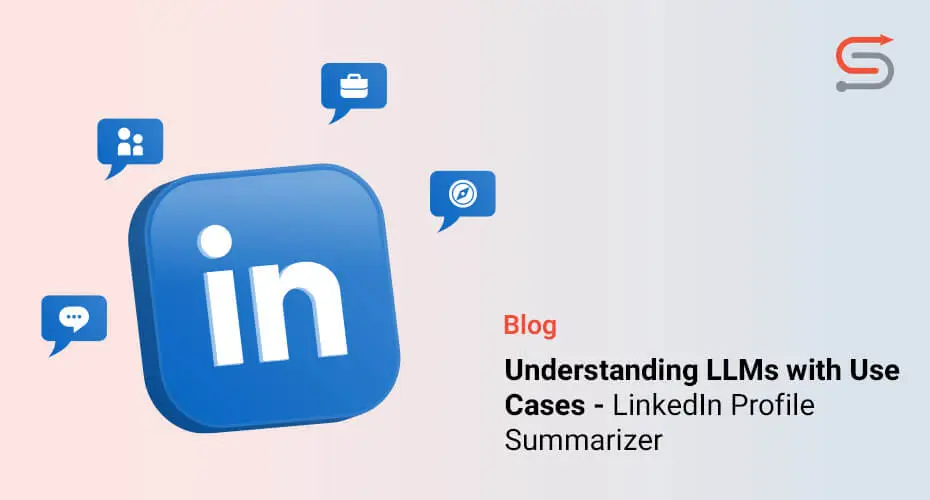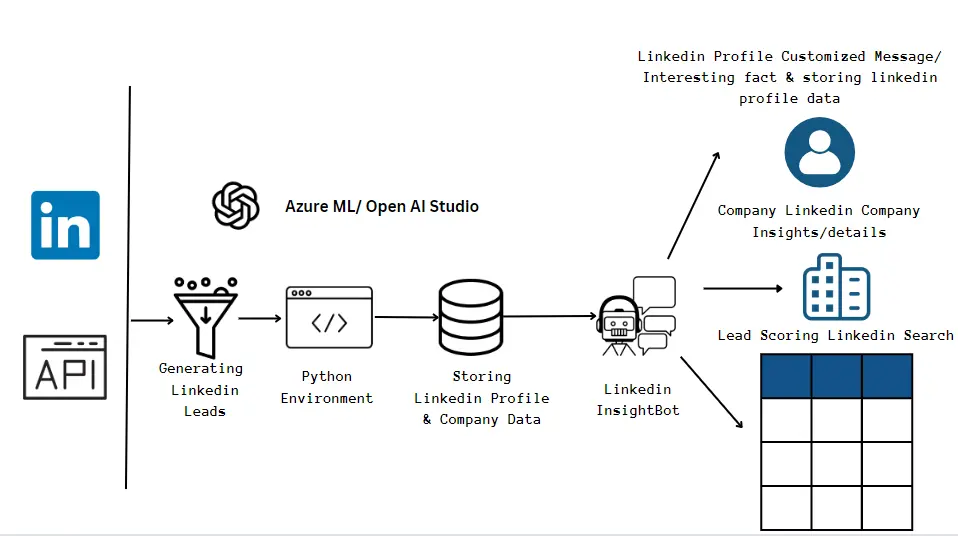October 6, 2023 - by Anish Purohit
For sales and marketing teams, top priorities are streamlining lead management, improving lead quality, and enabling personalized lead nurturing campaigns. But very often, limited profile information hinders understanding potential connections’ unique qualities. Simultaneously, time constraints limit personalized interaction.

In this second blog of this 2-part series, learn how Large Language Models (LLMs) like ChatGPT can allow sales and marketing professionals to build a LinkedIn profile summarizer and streamline lead generation.
Enhancing Lead Generation Outcomes With LLMs
Large Language Models offer several opportunities for sales and marketing teams to optimize lead-generation strategies and enable data-driven decision-making. LLMs facilitate efficient lead handoff and collaboration by promoting sales and marketing alignment. In the long run, these transformative models drive business growth by enhancing lead management, improving lead quality, and fostering effective sales and marketing processes.
Using LLMs, sales and marketing teams can enjoy several benefits across the lead management process, including:
- Personalization: LLMs can leverage AI and data insights to analyze LinkedIn profiles and generate personalized icebreakers tailored to each individual profile. This personal touch can help sales professionals make a stronger first impression and foster more authentic connections.
- Data-Driven Insights: LLMs can provide data-driven insights about prospects, helping sales and marketing professionals better understand their audience’s preferences and needs. This enables them to tailor their pitches and marketing strategies for more effective communication.
- Efficiency and Productivity: By automating the process of generating personalized campaigns and content, LLMs can save sales professionals time and effort. This can allow them to focus on building valuable relationships and driving long-term business growth.
Building a LinkedIn Profile Summarizer with LLMs
When it comes to lead generation, business platforms like LinkedIn act as great resources to attract potential customers. Since LinkedIn’s typical audience comprises professional decision-makers with decent purchasing power, sales, and marketing teams can leverage the platform to find and attract potential customers and nurture them for conversion.

LinkedIn LLM Bot Architecture
Here are six steps to take to build an LLM-based LinkedIn profile summarizer:
1. Understand the Business Context
The first step in building an LLM bot is gaining insights into the current utilization of LinkedIn and the approach toward engaging prospects. Thoroughly examining historical lead data, including factors such as location, education levels, and preferred communication mediums, is crucial.
2. Enable Data Integration
To enrich the leads database, merging existing LinkedIn leads with those generated by a chatbot is essential. Precise querying techniques play a pivotal role, as the chatbot filters and stores data based on user queries. This process involves generating leads using the chatbot’s prompts and efficiently storing them in the database.
3. Ensure Campaign Alignment
Leveraging insights derived from the initial plays a vital role in campaign execution. Craft prompts that incorporate keywords specific to the campaign’s objectives enable the LLM to filter and identify the best possible matches efficiently.
4. Enable LinkedIn Integration
To drive the best lead generation outcomes, make sure to have the LLM-enabled bot operate in three primary ways:
- Lead Scoring using LinkedIn: Utilize LinkedIn’s profile data and employ the LLM model to filter results based on their relevance to user queries and effectively score the leads.
- LinkedIn Profile Insights: Use the chatbot to extract and present essential information about the person, facilitating meaningful conversations using the LinkedIn API.
- LinkedIn Company Insights: Leverage available LinkedIn profile data in the database to capture company names. Use the LinkedIn API to gather additional information, including recent posts and company expertise, to provide valuable insights.
5. Ensure Continuous Monitoring and Improvement
It is important to evaluate the performance of the LLM-based lead generation solution regularly. To do this, monitor the quality of leads generated, measure conversion rates, and gather feedback from the sales team. Use this information to refine and enhance the LLM model, including prompts and filtering criteria.
6. Maintain Compliance and Data Privacy
While building an LLM-based model, it is critical to maintain compliance and data privacy. Ensure that your lead generation solution adheres to relevant data protection and privacy regulations, such as GDPR or CCPA. Implement appropriate security measures to safeguard sensitive customer information.
Every organization today looks to attract prospects and increase their interest through nurturing with the end goal of converting them into a customer. While cold calling, online advertising, email, and social media marketing are great ways to generate leads, LinkedIn acts as an incredibly powerful platform for lead generation.
Leveraging the capabilities of LLMs and partnering with an AI solutions expert can enable sales and marketing teams to build cutting-edge LinkedIn profile summarizers, attract the right leads, and generate more business opportunities.
About the Author
Anish Purohit is a certified Azure Data Science Associate with over 11 years of industry experience. With a strong analytical mindset, Anish excels in architecting, designing, and deploying data products using a combination of statistics and technologies. He is proficient in AL/ML/DL and has extensive knowledge of automation, having built and deployed solutions on Microsoft Azure and AWS and led and mentored teams of data engineers and scientists.



